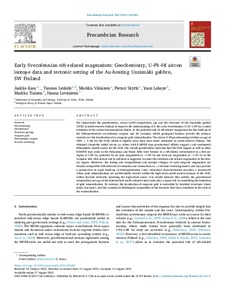Early Svecofennian rift-related magmatism: Geochemistry, U-Pb-Hf zircon isotope data and tectonic setting of the Au-hosting Uunimäki gabbro, SW Finland
Kara Jaakko; Leskelä Tuomas; Väisänen Markku; Skytta Pietari; Lahaye Yann; Tiainen Markku; Leväniemi Hanna
https://urn.fi/URN:NBN:fi-fe2021100750264
Tiivistelmä
We characterise the geochemistry, zircon Lu-Hf composition, age and the structure of the Uunimaki gabbro (UGB) in south-western Finland to improve the understanding of i) the early Svecofennian (1.92-1.89 Ga) crustal evolution of the central Fennoscandian Shield, ii) the potential role of rift-related magmatism for the build-up of the Paleoproterozoic accretionary orogens and iii) evaluate, which geological features provide the primary control over the localization of an orogenic gold mineralisation. The zircon U-Pb geochronology defines an age of 1891 +/- 5 Ma for the UGB, which is slightly older than most mafic intrusions in south-western Finland. The obtained chondritic initial zircon eHf values with E-MORB type geochemical affinity suggest a sub continental lithospheric mantle source for the UGB. The overall geochemistry indicates that the UGB magma as well as other E-MORB type rocks in the Pirkanmaa and Hame belts were formed in a rift-related environment in a fore-arc region at 1.89 Ga, predated by arc-type magmatism at similar to ~1.90 Ga and back-arc magmatism at similar to ~1.92 Ga in the Tampere belt. Slab retreat due to roll-back is suggested to cause the extension and related magmatism in the forearc region. Moreover, the timing and compositional and isotopic changes of early-orogenic magmatism are broadly compatible with intervals of extension and contraction, i.e., a tectonic switching model, and may provide a perspective to rapid build-up of Paleoproterozoic crust. Structural characterisation provides a framework where gold mineralisations are preferentially located within the high-strain north-eastern domain of the UGB, within fracture networks adjoining the high-strain zones. Our results indicate that neither the geochemical composition nor age of the intermediate-mafic intrusive host rocks play a major role in controlling the formation of gold mineralisation. By contrast, the localization of orogenic gold is controlled by localised structures (shear zones, fractures), and the variation in lithological composition of the intrusive host may contribute to the style of the mineralisation.
Kokoelmat
- Rinnakkaistallenteet [27094]
